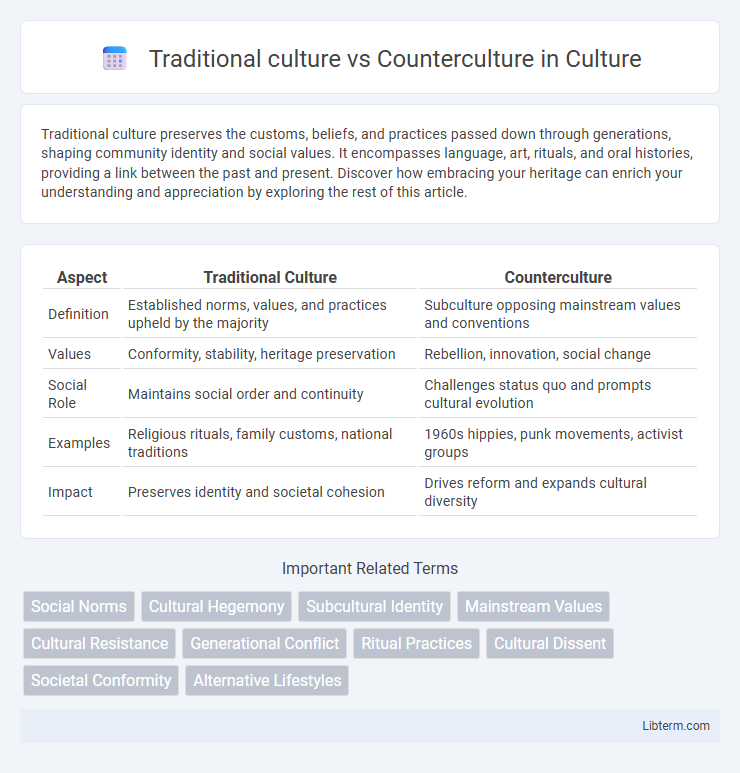Traditional culture preserves the customs, beliefs, and practices passed down through generations, shaping community identity and social values. It encompasses language, art, rituals, and oral histories, providing a link between the past and present. Discover how embracing your heritage can enrich your understanding and appreciation by exploring the rest of this article.
Table of Comparison
| Aspect | Traditional Culture | Counterculture |
|---|---|---|
| Definition | Established norms, values, and practices upheld by the majority | Subculture opposing mainstream values and conventions |
| Values | Conformity, stability, heritage preservation | Rebellion, innovation, social change |
| Social Role | Maintains social order and continuity | Challenges status quo and prompts cultural evolution |
| Examples | Religious rituals, family customs, national traditions | 1960s hippies, punk movements, activist groups |
| Impact | Preserves identity and societal cohesion | Drives reform and expands cultural diversity |
Understanding Traditional Culture: Core Values and Practices
Traditional culture centers on preserving established customs, beliefs, and social norms handed down through generations, emphasizing values such as family loyalty, respect for authority, and community cohesion. Core practices often include rituals, festivals, language use, and religious observances that reinforce identity and continuity within a society. Understanding traditional culture involves recognizing its role in maintaining social order, shaping individual behavior, and providing a sense of belonging and stability.
Defining Counterculture: Roots and Characteristics
Counterculture emerges as a social movement that directly opposes dominant traditional culture values, often rooted in political activism, artistic expression, and alternative lifestyles during the 1960s and 1970s. Key characteristics include rejection of mainstream norms, advocacy for social change, and embracing nonconformity through distinctive dress, music, and communal living. Influences from the Beat Generation, civil rights movements, and anti-war protests shaped counterculture's foundational ethos, emphasizing individual freedom and systemic critique.
Historical Overview: Traditional Culture vs Counterculture
Traditional culture, rooted in long-standing customs, values, and social norms, has historically dominated societies by emphasizing continuity and stability, often reflected in religious practices, family structures, and established institutions. Counterculture movements, emerging prominently during the 1960s with groups like the Hippies, rejected mainstream societal norms, advocating for alternative lifestyles, civil rights, anti-war protests, and greater individual freedom. This historical clash highlights the tension between preservation of inherited cultural frameworks and transformative social change driven by youthful rebellion and ideological dissent.
Social Influence: How Traditions Shape Communities
Traditional culture reinforces social cohesion by upholding shared customs, values, and rituals that provide a clear identity and continuity in communities. These long-standing traditions foster strong social bonds, guiding behavior and expectations within the group. In contrast, counterculture challenges established norms, often creating alternative social influence that can disrupt or transform community dynamics.
The Rise of Countercultural Movements
The rise of countercultural movements emerged in the 1960s as a significant response against traditional culture's rigid social norms, emphasizing freedom, anti-establishment values, and alternative lifestyles. Key movements such as the Beat Generation, Hippies, and the Civil Rights Movement challenged conventional beliefs, promoting peace, environmentalism, and individual expression. These movements influenced music, art, and politics, reshaping societal values and triggering widespread cultural transformations.
Conflict and Coexistence: Navigating Differences
Traditional culture often emphasizes established norms, values, and practices that maintain social order and continuity, while counterculture challenges these conventions by promoting alternative lifestyles and ideologies. The conflict arises from the clash between preservation of heritage and the desire for social or political change, leading to tensions in identity and community cohesion. Coexistence is navigated through mutual adaptation, dialogue, and selective integration, allowing both traditional and countercultural elements to influence societal evolution.
Media Representation: Tradition vs Counterculture Narratives
Traditional culture in media often emphasizes established values, social norms, and continuity, portraying stability and conformity as central themes. Counterculture narratives highlight resistance to these norms, showcasing alternative lifestyles, radical ideas, and social change movements to challenge mainstream ideology. Media representation plays a crucial role in framing tradition as the default and counterculture as disruptive, influencing public perception and cultural discourse.
Generational Perspectives on Culture
Traditional culture often reflects long-standing values and social norms upheld across multiple generations, emphasizing continuity and respect for heritage. Counterculture frequently emerges as a reaction from younger generations seeking to challenge or redefine these established norms, promoting new ideas and alternative lifestyles. Generational perspectives reveal a dynamic tension where youth-driven movements question authority and tradition, while older generations prioritize cultural preservation and stability.
Impact on Identity and Self-Expression
Traditional culture reinforces identity by promoting shared values, customs, and rituals that provide a sense of belonging and continuity across generations. Counterculture challenges mainstream norms, encouraging individuals to express unique perspectives and redefine personal identity through alternative lifestyles, art, and social movements. This dynamic tension shapes societal evolution, influencing how people perceive themselves and their role within the community.
Future Trends: Integration or Polarization?
Future trends suggest an increasing polarization between traditional culture and counterculture as divergent values and technological impacts solidify distinct social groups. Integration remains possible through digital platforms fostering cross-cultural dialogues and hybrid identities combining heritage with innovation. Data from sociological studies indicate that younger generations may drive nuanced blending, yet entrenched ideological divides pose significant barriers to seamless amalgamation.
Traditional culture Infographic

 libterm.com
libterm.com